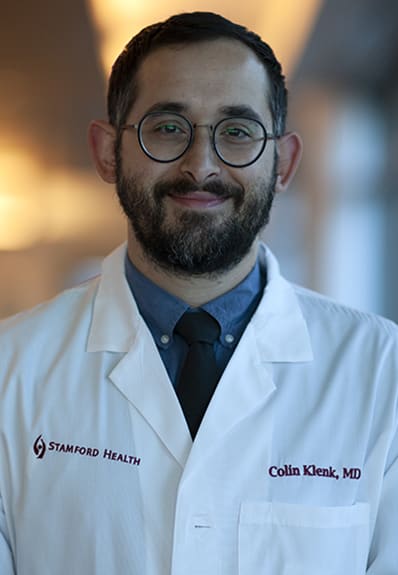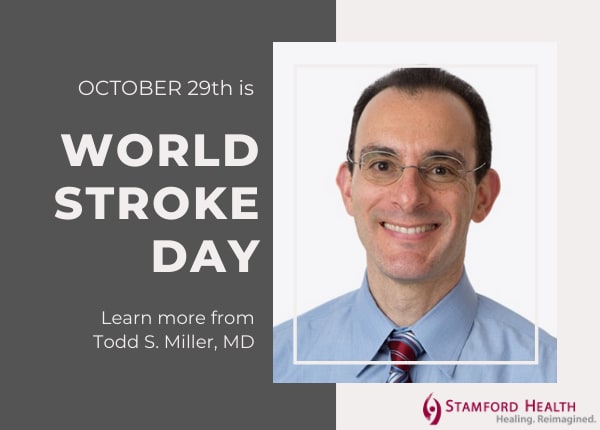By Colin Klenk, MD
Drooping face. Weak arm. Lost balance. Trouble speaking. Any of these symptoms could be a sign of stroke, a leading — and largely preventable — cause of death and disability in the United States. Spotting these signs quickly is so crucial to recovery that there is an acronym to help you:
F.A.S.T.: Face drooping, arm weakness, speech difficulty — any of these signs indicate it's time to call 911. The faster you recognize and respond to these warning signs, the greater the chances are that you or your loved one will make a full recovery. Of course, the best medicine for stroke is prevention, which calls for minimizing your risk.
Anyone can have a stroke, regardless of age or gender, and symptoms such as numbness or weakness of the face or leg, especially on one side of the body; trouble seeing or walking; severe headache with no known cause; or balance and coordination problems affect men and women. Yet, women, especially Black women, face a higher risk of stroke than men, possibly because they have particular risk factors, like pregnancy, preeclampsia (high blood pressure during pregnancy), oral contraceptive use, hormone replacement therapy, migraines with aura, or atrial fibrillation.
The effects of stroke depend on what part and how much of the brain it damages. For example, a stroke that occurs toward the back of the brain may result in vision problems, whereas a stroke that affects one side of the brain may disrupt neurological function on the opposite side of the body. A small stroke may cause temporary weakness in an arm or leg, while a large stroke may cause permanent paralysis on one side of the body.
Assessing stroke involves testing an individual's physical strength and sensation, as well as speech and vision. Timely assessment and treatment of a stroke offers the best chance for functional recovery in the long term. Physical rehabilitation following hospitalization can also help patients regain their previous abilities and functioning. This may include occupational therapy, speech therapy, and medications. Joining a support group may also help patients adjust to life after a stroke. Support from family and friends also plays an important role in recovery.
Strokes are so varied, and one person's road to recovery is going to look different from another's. For example, younger patients, including children, tend to fair better than older patients because their brains have greater plasticity and resilience, while older patients may have co-morbidities that can complicate their recovery.
Drooping face. Weak arm. Lost balance. Trouble speaking. Any of these symptoms could be a sign of stroke, a leading — and largely preventable — cause of death and disability in the United States. Spotting these signs quickly is so crucial to recovery that there is an acronym to help you:
F.A.S.T.: Face drooping, arm weakness, speech difficulty — any of these signs indicate it's time to call 911. The faster you recognize and respond to these warning signs, the greater the chances are that you or your loved one will make a full recovery. Of course, the best medicine for stroke is prevention, which calls for minimizing your risk.
Causes of stroke
A stroke occurs when a blood clot or ruptured artery obstructs blood flow to the brain, starving it of oxygen and quickly killing brain cells. Most strokes are ischemic, resulting from a blood clot or other particle in a blood vessel the prevents blood from reaching the brain. A hemorrhagic stroke occurs when an artery in the brain leaks or ruptures, filling the surrounding area with blood, and putting damaging pressure on brain cells. A transient ischemic attack or “mini-stroke” also results from a clot-related obstruction of blood flow to the brain but then resolves. While TIAs are short-lived, it is considered a warning sign for future stroke and therefore requires immediate emergency care.Anyone can have a stroke, regardless of age or gender, and symptoms such as numbness or weakness of the face or leg, especially on one side of the body; trouble seeing or walking; severe headache with no known cause; or balance and coordination problems affect men and women. Yet, women, especially Black women, face a higher risk of stroke than men, possibly because they have particular risk factors, like pregnancy, preeclampsia (high blood pressure during pregnancy), oral contraceptive use, hormone replacement therapy, migraines with aura, or atrial fibrillation.
Signs of stroke
Certain signs of stroke, like overall weakness and fatigue, disorientation and confusion, memory problems, nausea, or vomiting, are not only particular to women but also might be too subtle for providers to spot or diagnose accurately. Moreover, common stroke symptoms such as unusual tiredness, nausea, or vomiting, could resemble those of heart attack. A lot of times women with acute heart attack can have numbness and weakness, particularly on their left side, which can mimic signs of a stroke.Risk factors for stroke
Even risk factors for heart attack and stroke can overlap. These include chronic and short-term stress, smoking, obesity, and diabetes. For both conditions, prevention through stress reduction, regular exercise, healthy eating, and not smoking are key to minimizing risks.The effects of stroke depend on what part and how much of the brain it damages. For example, a stroke that occurs toward the back of the brain may result in vision problems, whereas a stroke that affects one side of the brain may disrupt neurological function on the opposite side of the body. A small stroke may cause temporary weakness in an arm or leg, while a large stroke may cause permanent paralysis on one side of the body.
Assessing stroke involves testing an individual's physical strength and sensation, as well as speech and vision. Timely assessment and treatment of a stroke offers the best chance for functional recovery in the long term. Physical rehabilitation following hospitalization can also help patients regain their previous abilities and functioning. This may include occupational therapy, speech therapy, and medications. Joining a support group may also help patients adjust to life after a stroke. Support from family and friends also plays an important role in recovery.
Strokes are so varied, and one person's road to recovery is going to look different from another's. For example, younger patients, including children, tend to fair better than older patients because their brains have greater plasticity and resilience, while older patients may have co-morbidities that can complicate their recovery.
About the Author
Colin Klenk, MD, is a neurologist at Stamford Health.Featured Expert/ Author








